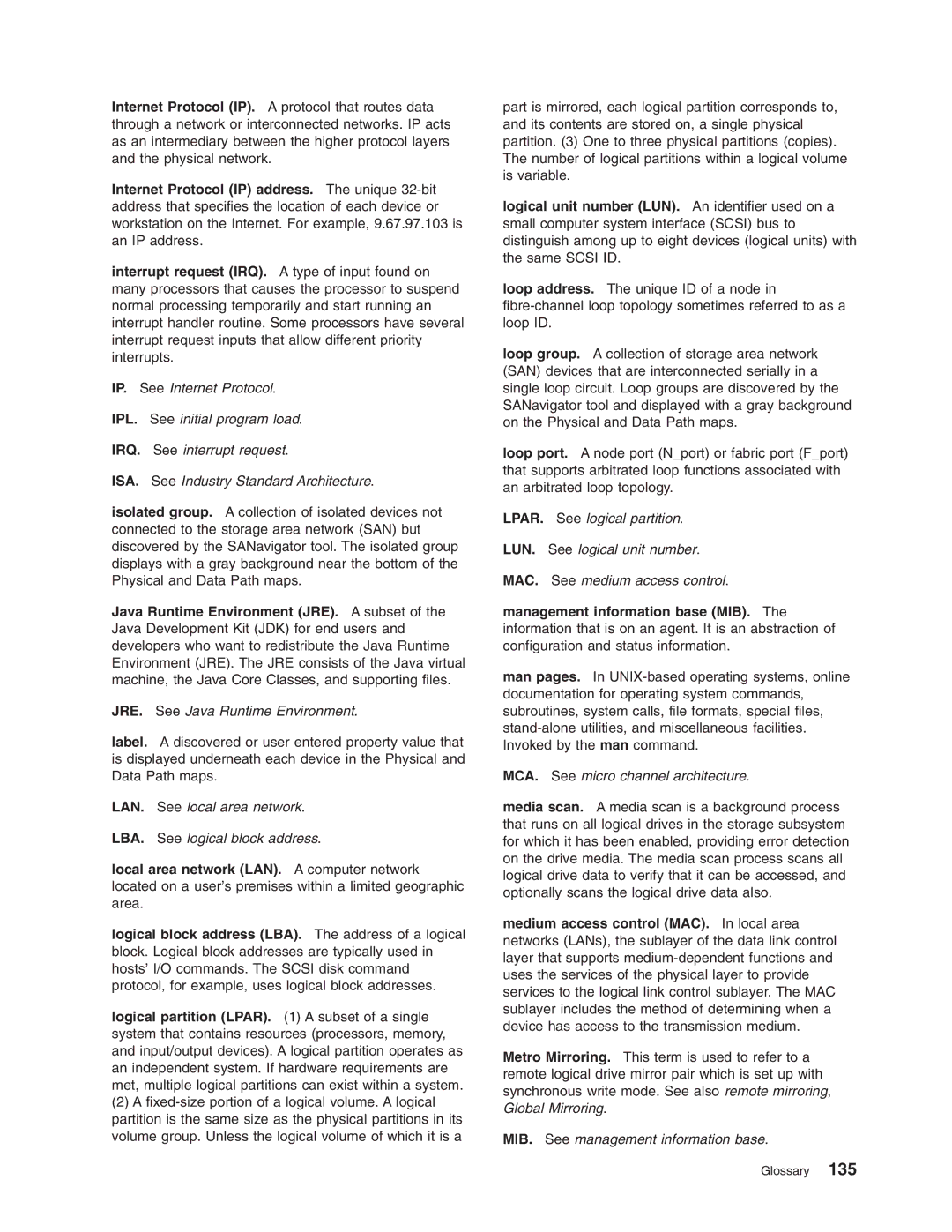Internet Protocol (IP). A protocol that routes data through a network or interconnected networks. IP acts as an intermediary between the higher protocol layers and the physical network.
Internet Protocol (IP) address. The unique
interrupt request (IRQ). A type of input found on many processors that causes the processor to suspend normal processing temporarily and start running an interrupt handler routine. Some processors have several interrupt request inputs that allow different priority interrupts.
IP. See Internet Protocol.
IPL. See initial program load.
IRQ. See interrupt request.
ISA. See Industry Standard Architecture.
isolated group. A collection of isolated devices not connected to the storage area network (SAN) but discovered by the SANavigator tool. The isolated group displays with a gray background near the bottom of the Physical and Data Path maps.
Java Runtime Environment (JRE). A subset of the Java Development Kit (JDK) for end users and developers who want to redistribute the Java Runtime Environment (JRE). The JRE consists of the Java virtual machine, the Java Core Classes, and supporting files.
JRE. See Java Runtime Environment.
label. A discovered or user entered property value that is displayed underneath each device in the Physical and Data Path maps.
LAN. See local area network.
LBA. See logical block address.
local area network (LAN). A computer network located on a user’s premises within a limited geographic area.
logical block address (LBA). The address of a logical block. Logical block addresses are typically used in hosts’ I/O commands. The SCSI disk command protocol, for example, uses logical block addresses.
logical partition (LPAR). (1) A subset of a single system that contains resources (processors, memory, and input/output devices). A logical partition operates as an independent system. If hardware requirements are met, multiple logical partitions can exist within a system.
(2)A
part is mirrored, each logical partition corresponds to, and its contents are stored on, a single physical partition. (3) One to three physical partitions (copies). The number of logical partitions within a logical volume is variable.
logical unit number (LUN). An identifier used on a small computer system interface (SCSI) bus to distinguish among up to eight devices (logical units) with the same SCSI ID.
loop address. The unique ID of a node in
loop group. A collection of storage area network (SAN) devices that are interconnected serially in a single loop circuit. Loop groups are discovered by the SANavigator tool and displayed with a gray background on the Physical and Data Path maps.
loop port. A node port (N_port) or fabric port (F_port) that supports arbitrated loop functions associated with an arbitrated loop topology.
LPAR. See logical partition.
LUN. See logical unit number.
MAC. See medium access control.
management information base (MIB). The information that is on an agent. It is an abstraction of configuration and status information.
man pages. In
MCA. See micro channel architecture.
media scan. A media scan is a background process that runs on all logical drives in the storage subsystem for which it has been enabled, providing error detection on the drive media. The media scan process scans all logical drive data to verify that it can be accessed, and optionally scans the logical drive data also.
medium access control (MAC). In local area networks (LANs), the sublayer of the data link control layer that supports
Metro Mirroring. This term is used to refer to a remote logical drive mirror pair which is set up with synchronous write mode. See also remote mirroring, Global Mirroring.
MIB. See management information base.
Glossary 135
